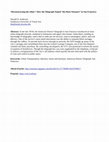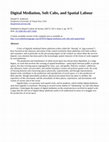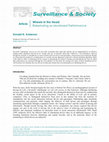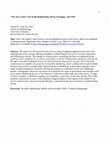Papers by Donald Anderson

Journal of Urban History, 2018
In the late 1870s, the American District Telegraph in San Francisco introduced an intra-urban tel... more In the late 1870s, the American District Telegraph in San Francisco introduced an intra-urban telegraph network, marketed to businesses and upper-class homes. Subscribers, needing no knowledge of telegraphy, used a dial to order pre-set services, such as messengers, police, and coal delivery. One of the service's most noted innovations was the ability to summon hired carriages through the callbox. To provide hack service through its network, the ADT bought up many of the city's carriages and consolidated them into the United Carriage Company, one of the first dispatch-oriented cab fleets anywhere. By controlling cab dispatch, the UCC also promised to reform the unruly occupation of hackdrivers. Though the telegraph box was soon supplanted by the telephone, it had put in motion a reorganization of the city's cab industry which quickly became intricated with the politics of class and control in public space.

Digital Culture & Society, 2017
Critics of digitally mediated labour platforms (often called the " sharing " or " gig economy ") ... more Critics of digitally mediated labour platforms (often called the " sharing " or " gig economy ") have focused on the character and extent of the control exerted by these platforms over both workers and customers, and in particular on the precarizing impact on the workers on whose labor the services depend. Less attention has been paid to the increasingly spatial character of the forms of work targeted by such platforms. The production and maintenance of urban social space has always been dependent, to a large degree, on work that involves the crossing of spatial boundaries—particularly between public to private spaces, but also crossing spaces segregated by class, race, and gender. Delivery workers, cabdrivers, day labourers, home care providers, and similar boundary-crossers all perform spatial work: the work of moving between and connecting spaces physically, experientially, and through representation. Spatial work contributes to the production and reproduction of social space; it is also productive of three specific, though interrelated, products: physical movement from one place to another; the experience of this movement; and the articulation of these places, experiences, and movements with visions of society and of the social. Significantly, it is precisely such spatial work, and its products, which mobile digital platforms seek most urgently to transform. Drawing on several recent studies of " ridesharing " (or soft cab) labour platforms, I interrogate the impact of digital mediation on the actual practices involved in spatial work. I argue that the roll-out of digital labour platforms needs to be understood in terms of a struggle over the production of social space.
http://www.thirdcarriageage.com/2018/01/how-ludwig-van-beethoven-invented.html

Surveillance & Society, 2016
For-profit “ridesharing” services (or soft cabs) offer on-demand rides much like taxicabs, but ar... more For-profit “ridesharing” services (or soft cabs) offer on-demand rides much like taxicabs, but are distinguished by an affective framing which emphasizes that drivers are “friends with cars, on demand” rather than “cabdrivers.” This reframing is achieved through the insertion of smartphones as social interfaces between drivers and passengers, restructuring social interaction through an allegorithm (the productive co-deployment of a socially relevant allegorical script and a software-mediated algorithm). Much of the affective labor of these drivers consists in maintaining this affective framing and internalizing the logic by which their performances are monitored through the work platform. In this article the writings and videos of three soft-cab drivers will be drawn on to illustrate the ways drivers develop and evaluate their own performances as "ridesharing."
http://taxicabsubjects.blogspot.com/2016/03/san-franciscos-early-jitneys.html
http://taxicabsubjects.blogspot.com/2016/03/a-spectre-is-haunting-uber-jason.html

This dissertation investigates cabdriving as a form of spatial work, involved in the production a... more This dissertation investigates cabdriving as a form of spatial work, involved in the production and reproduction of social space through three interrelated products: physical movement from place to place; the experience of movement, of connection made between places; and the articulation of these places, movements, and experiences with visions of society and the social. The particular forms of knowledge involved in this work, and the politics in which taxicabs are imbricated, are explored through fieldwork conducted in two very different cities: Mexico City and San Francisco, California. The political context of cabdriving knowledge changes as new technologies are introduced into the cab to reframe the relationship between the interior of the cab (where passengers and drivers interact) and the exteriors (urban and informational spaces) through which it passes.
In Mexico City, interviews with libre, base, and sitio cabdrivers about their knowledge and work strategies revealed three aspects of cabdriving as a rhythmanalytical practice 1) the points of confluence, or the geographic mode of intersection or confluence by which drivers link up with passengers; 2) the temporal and monetary patterns of constraint the occupation puts on drivers; and 3) the sense of the city which emerges, as this is described by drivers. Each form of taxicab has different patterns of movement, and different spatial and technological means of establishing contact with customers, which results in differing experiences and strategies elaborated by drivers.
In San Francisco, interviews were conducted with taxi, limousine, and “ridesharing” drivers on the impact of smartphone-enabled “e-hailing” technology. The term allegorithm (the productive co-deployment of a socially relevant allegorical script and a software-mediated algorithm) is borrowed from gaming studies to describe how interfaces reframe the cab-riding experience. Of particular interest is the emergene of “ridesharing,” or the overcab (a cab-riding experience which is superior to the experience of riding in a cab). The effectiveness of the overcab’s reframing project depends on the acceptance and performance by participants of the “overcab” narrative. There are indications that the transcendence of the overcab is fragile, and that cracks are developing in the experiences of both drivers and passengers, due to continuing tensions which the overcab has failed to resolve, or which have been introduced as part of its regulating mechanism.

Semiotica 2014(202): 609-629, Oct 2014
The forms of emblematic gesture and other communicative moves used in hailing taxicabs are shaped... more The forms of emblematic gesture and other communicative moves used in hailing taxicabs are shaped by the urban built environment and by the micropolitics sparked by what Goffman called the “loose coupling” of the interaction and social orders. Cabdrivers evaluate street hails and choose whether or not to stop for prospective passengers; hailers seek to communicate their desirability as passengers within the limited mode of the street hail. The conditions and constraints that underlie the practice and reception of street hailing are considered. A survey on methods used to hail taxis was sent to a listserv of taxi drivers in San Francisco, California. The drivers evaluated street hails in terms of two axes – clarity and propriety – and three levels of context: the immediate interactional context of the street; the anticipated interactional context of the cab ride; and the political context, or the political discourse framing taxicab regulation in the city.
Encyclopedia of Transportation: Social Science and Policy, 2014
Taking a global view of the taxi industry, the entry covers common labor issues facing taxicab d... more Taking a global view of the taxi industry, the entry covers common labor issues facing taxicab drivers, from occupational and health hazards, to issues of employment context, social status, and skill, concluding that labor conditions for taxicab drivers are shaped by: 1) the relative amount of influence or control drivers have over their own working conditions; 2) the occupational prestige and class context of taxi driving as an occupation; and 3) the extent to which drivers are considered to be skilled or unskilled, and the extent to which driver skill is recognized or cultivated by regulation and the industry in general.

Transportation, May 2014
"The spread of GPS-based location services using smartphone applications has led to the rapid gro... more "The spread of GPS-based location services using smartphone applications has led to the rapid growth of new startups offering smartphone-enabled dispatch service for taxicabs, limousines, and ridesharing vehicles. This change in communicative technology has been accompanied by the creation of new categories of car service, particularly as drivers of limousines and private vehicles use the apps to provide on-demand service of a kind previously reserved for taxicabs. One of the most controversial new models of car service is for-profit ridesharing, which combines the for-profit model of taxi service with the overall traffic reduction goals of ridesharing. A preliminary attempt is here made at understanding how for-profit ridesharing compares to traditional taxicab and ridesharing models. Ethnographic interviews are drawn on to illustrate the range of motivations and strategies used by for-profit ridesharing drivers in San Francisco, California as they make use of the service. A range of driver strategies is identified, ranging from incidental, to part-time, to full-time driving. This makes possible a provisional account of the potential ecological impacts of the spread of this model of car service, based on the concept of taxicab efficiency, conceived as the ratio of shared versus unshared miles driven. The on/off flexibility of the for-profit ridesharing model has the potential to lead to either more or less efficiency compared to traditional dedicated taxicab vehicles, depending ultimately on the ratio of driving strategies (incidental, part-time, or full-time) adopted by drivers.At the same time, the deregulatory threat posed by the for-profit model of ridesharing could contribute to increased pollution and congestion through the erosion of regulatory controls on taxicab vehicle numbers and standards."

We are accustomed to thinking of the human body as the site of subjectivity, sensation, and exper... more We are accustomed to thinking of the human body as the site of subjectivity, sensation, and experience, but prosthetic technologies, from everyday tools to communicative networks, problematize the apparent boundary between the human body and the world beyond. A growing appreciation of the nuances of sociotechnical systems has superceded older fears of the technological “artificial” displacing authentically “natural” human experience; yet rather than naturalizing or excusing technological change, this recognition is best put to use to render more clear the political effects produced as shifting assemblages of humans and non-humans transform the sites and boundaries of choice, action, and experience.
In this paper I look at “e-hailing,” the use of smartphone applications to “hail” taxicabs and similar vehicles. Despite the name, these applications do more than supplement the traditional physical gestures by which taxis are hailed from sidewalks, but additionally take the affective social interaction between driver and passenger (as “moral persons”) as a problem to be solved through the re-articulation of bodies, affects, and devices into a new assemblage governed by an allegorithm, the productive co-deployment of a socially relevant allegorical script and a software-mediated algorithm.
Flows of affect, sensation, and experience are routed through this new assemblage, while emergent values such as “trust” and “community” are orchestrated through the allegorithm, and concretized in and through user profiles, ratings systems, and credit approval. The e-hailing assemblage constructs a social space inside a productive boundary within which meaningful choices and interactions can take place; this functions by emphasizing particular relations of agency, feeling, and sensation while obscuring or disabling others. In this paper I will draw on participant observation and ethnographic interviews with taxi, limousine, and “ridesharing” drivers in San Francisco to elucidate the ways drivers and passengers experience and respond to this project.

"Many theorists have noted the central role of affect in the cultural practice of automobility, p... more "Many theorists have noted the central role of affect in the cultural practice of automobility, particularly in the US. Affect is central to the self-making of automotive subjects – as car drivers, or as passengers – as well as to the production of social space through the mediation of the vehicle as a shared site of movement and interaction. The political nature of automotive affectivity comes to the fore when the driver-passenger relationship is a paid service, and the affective labor of shaping the riding experience and the mood of in-car interaction overlays and politically contextualizes the work of driving itself.
In turn, the micropolitical context of driving as affective labor affects the development of transport politics, governance, and technology. This is illustrated by the peculiar trajectory of growth in Online Enabled Transport Services (OETS) which use smartphones to link passengers to drivers of hired vehicles. The adoption of this technology in the US has become imbricated with the affective politics of driving and passengering. The deployment of OETS has become a project of reframing the affective labor of driving through a splintering of available modes, distinguished primarily by the affective roles expected of drivers (and of passengers): chauffeur or private driver; cabdriver; or a “friend with a car” who “shares a ride” for a suggested donation, rather than a fee. This paper will draw on ethnographic interviews with OETS and taxi drivers in the city of San Francisco."

Abstract:
New transportation technologies have the potential to transform social relations and s... more Abstract:
New transportation technologies have the potential to transform social relations and social space, for better or worse. Yet the actual processes through which these technologies are imagined and adopted get entangled in existing political economies of affect and identity, not to mention flows of investment and extraction. San Francisco has emerged as a proving ground for a number of new-tech startups which use GPS locating to allow passengers to "hail" nearby taxis, limos, and other vehicles with mobile smartphone apps. Funded by Silicon Valley venture capital, these services bypass traditional forms of dispatch to establish more direct, trackable connections between drivers and passengers, mediated of course by the service provider. The most controversial of these are marketed as "ridesharing" services, in which transportation is provided, not for a price, but a calculated donation alone. By reframing the affective work of driving and passengering into a relationship of friendship rather than a market exchange, they blur the boundaries between work and play, between public and private vehicles, and between payment and gift. While promising to transform the meaning and experience of the shared vehicle as a mobile, liminal site within the larger, contested space of the city, these new services contribute to increased urban "splintering" and the stratification of access to mobility, while harnessing progressive environmental goals such as ridesharing and the "sharing economy" to the promotion of transport deregulation and a free market ideology.

Surveillance and Society, Sep 2012
"
Since security cameras were first required in San Francisco taxicabs in 2003, their unfolding ... more "
Since security cameras were first required in San Francisco taxicabs in 2003, their unfolding story has come to contain many elements familiar to surveillance studies: the initial introduction of new technology in the wake of a moral panic; a failure of maintenance and a lapse into unreliability; and finally a resurgence accompanied by surveillance creep. This trajectory is explored using the concept of “surveillance slack,” and the stages of slackening and tensing of taxicab camera surveillance will be considered in terms of their shaping by issues of acceptability (where the line between use and abuse is drawn), of effectiveness (what the cameras are perceived to be doing), and, underlying both of these, of integration, that is, how the slackness or tautness of surveillance interacts with existing lines of tension and conflict in the taxi industry."
The practice of tipping for particular services has long puzzled economists and social scientist... more The practice of tipping for particular services has long puzzled economists and social scientists. In many contexts, tipping is related to contradictions which tippers and tippees feel between, on the one hand, the provision of affective labor (or “emotion work”), and on the other, deeply held preconceptions regarding what sorts of work are “productive” and can or cannot be recompensed. In this paper I explore how cabdrivers and passengers in San Francisco introduce a “moral economy” into the tipping transaction as a response to these felt contradictions, in a limited, momentary transformation of the depersonalizing logic of the money form.

Journal of Linguistic Anthropology, Jan 1, 2011
The Northern English Sheep Counting Score, a stray numeral system, has been vexing folklorists an... more The Northern English Sheep Counting Score, a stray numeral system, has been vexing folklorists and linguists for over a hundred years. I suggest that the form of the score reflects a process of specialization distinct from the abstract mathematical functions which characterize common numeral systems. This specialization is explored through the use of Bakhtin’s concepts of minor and major chronotopes. Chronotopes, understood as the creation of spatiotemporal ground on which indexicality has meaning, are used to describe the ways that contiguity and sequence form dialogically interacting indexical relationships at various levels of analysis, from minimal adjacent pairs and rhythm, to performance, to the large-scale chronotopes organizing scholarly and popular discourses. [Sheep Count, chronotope, indexicality, numeral systems, ethnomathematics]
This study, based on participant observation and ethnographic interviews, investigates the discou... more This study, based on participant observation and ethnographic interviews, investigates the discourse of San Francisco cabdrivers concerning their occupation as a body of knowledges and strategies. This discourse is not treated as translucent in itself, but must be approached in terms of the interactional and occupational power relations which drivers experience in the course of their work. In particular this study focuses on the interplay of power and interpretive strategies in taxicab radio dispatch; this is contextualized historically and with reference to other ways in which drivers “play” cabdriving. The phrase “playing for hire” is intended to capture the contradictory nature of an occupation which combines liberating aspects such as mobility and freedom of interaction with drudgery, danger, and monetary calculation.











Uploads
Papers by Donald Anderson
In Mexico City, interviews with libre, base, and sitio cabdrivers about their knowledge and work strategies revealed three aspects of cabdriving as a rhythmanalytical practice 1) the points of confluence, or the geographic mode of intersection or confluence by which drivers link up with passengers; 2) the temporal and monetary patterns of constraint the occupation puts on drivers; and 3) the sense of the city which emerges, as this is described by drivers. Each form of taxicab has different patterns of movement, and different spatial and technological means of establishing contact with customers, which results in differing experiences and strategies elaborated by drivers.
In San Francisco, interviews were conducted with taxi, limousine, and “ridesharing” drivers on the impact of smartphone-enabled “e-hailing” technology. The term allegorithm (the productive co-deployment of a socially relevant allegorical script and a software-mediated algorithm) is borrowed from gaming studies to describe how interfaces reframe the cab-riding experience. Of particular interest is the emergene of “ridesharing,” or the overcab (a cab-riding experience which is superior to the experience of riding in a cab). The effectiveness of the overcab’s reframing project depends on the acceptance and performance by participants of the “overcab” narrative. There are indications that the transcendence of the overcab is fragile, and that cracks are developing in the experiences of both drivers and passengers, due to continuing tensions which the overcab has failed to resolve, or which have been introduced as part of its regulating mechanism.
In this paper I look at “e-hailing,” the use of smartphone applications to “hail” taxicabs and similar vehicles. Despite the name, these applications do more than supplement the traditional physical gestures by which taxis are hailed from sidewalks, but additionally take the affective social interaction between driver and passenger (as “moral persons”) as a problem to be solved through the re-articulation of bodies, affects, and devices into a new assemblage governed by an allegorithm, the productive co-deployment of a socially relevant allegorical script and a software-mediated algorithm.
Flows of affect, sensation, and experience are routed through this new assemblage, while emergent values such as “trust” and “community” are orchestrated through the allegorithm, and concretized in and through user profiles, ratings systems, and credit approval. The e-hailing assemblage constructs a social space inside a productive boundary within which meaningful choices and interactions can take place; this functions by emphasizing particular relations of agency, feeling, and sensation while obscuring or disabling others. In this paper I will draw on participant observation and ethnographic interviews with taxi, limousine, and “ridesharing” drivers in San Francisco to elucidate the ways drivers and passengers experience and respond to this project.
In turn, the micropolitical context of driving as affective labor affects the development of transport politics, governance, and technology. This is illustrated by the peculiar trajectory of growth in Online Enabled Transport Services (OETS) which use smartphones to link passengers to drivers of hired vehicles. The adoption of this technology in the US has become imbricated with the affective politics of driving and passengering. The deployment of OETS has become a project of reframing the affective labor of driving through a splintering of available modes, distinguished primarily by the affective roles expected of drivers (and of passengers): chauffeur or private driver; cabdriver; or a “friend with a car” who “shares a ride” for a suggested donation, rather than a fee. This paper will draw on ethnographic interviews with OETS and taxi drivers in the city of San Francisco."
New transportation technologies have the potential to transform social relations and social space, for better or worse. Yet the actual processes through which these technologies are imagined and adopted get entangled in existing political economies of affect and identity, not to mention flows of investment and extraction. San Francisco has emerged as a proving ground for a number of new-tech startups which use GPS locating to allow passengers to "hail" nearby taxis, limos, and other vehicles with mobile smartphone apps. Funded by Silicon Valley venture capital, these services bypass traditional forms of dispatch to establish more direct, trackable connections between drivers and passengers, mediated of course by the service provider. The most controversial of these are marketed as "ridesharing" services, in which transportation is provided, not for a price, but a calculated donation alone. By reframing the affective work of driving and passengering into a relationship of friendship rather than a market exchange, they blur the boundaries between work and play, between public and private vehicles, and between payment and gift. While promising to transform the meaning and experience of the shared vehicle as a mobile, liminal site within the larger, contested space of the city, these new services contribute to increased urban "splintering" and the stratification of access to mobility, while harnessing progressive environmental goals such as ridesharing and the "sharing economy" to the promotion of transport deregulation and a free market ideology.
Since security cameras were first required in San Francisco taxicabs in 2003, their unfolding story has come to contain many elements familiar to surveillance studies: the initial introduction of new technology in the wake of a moral panic; a failure of maintenance and a lapse into unreliability; and finally a resurgence accompanied by surveillance creep. This trajectory is explored using the concept of “surveillance slack,” and the stages of slackening and tensing of taxicab camera surveillance will be considered in terms of their shaping by issues of acceptability (where the line between use and abuse is drawn), of effectiveness (what the cameras are perceived to be doing), and, underlying both of these, of integration, that is, how the slackness or tautness of surveillance interacts with existing lines of tension and conflict in the taxi industry."
In Mexico City, interviews with libre, base, and sitio cabdrivers about their knowledge and work strategies revealed three aspects of cabdriving as a rhythmanalytical practice 1) the points of confluence, or the geographic mode of intersection or confluence by which drivers link up with passengers; 2) the temporal and monetary patterns of constraint the occupation puts on drivers; and 3) the sense of the city which emerges, as this is described by drivers. Each form of taxicab has different patterns of movement, and different spatial and technological means of establishing contact with customers, which results in differing experiences and strategies elaborated by drivers.
In San Francisco, interviews were conducted with taxi, limousine, and “ridesharing” drivers on the impact of smartphone-enabled “e-hailing” technology. The term allegorithm (the productive co-deployment of a socially relevant allegorical script and a software-mediated algorithm) is borrowed from gaming studies to describe how interfaces reframe the cab-riding experience. Of particular interest is the emergene of “ridesharing,” or the overcab (a cab-riding experience which is superior to the experience of riding in a cab). The effectiveness of the overcab’s reframing project depends on the acceptance and performance by participants of the “overcab” narrative. There are indications that the transcendence of the overcab is fragile, and that cracks are developing in the experiences of both drivers and passengers, due to continuing tensions which the overcab has failed to resolve, or which have been introduced as part of its regulating mechanism.
In this paper I look at “e-hailing,” the use of smartphone applications to “hail” taxicabs and similar vehicles. Despite the name, these applications do more than supplement the traditional physical gestures by which taxis are hailed from sidewalks, but additionally take the affective social interaction between driver and passenger (as “moral persons”) as a problem to be solved through the re-articulation of bodies, affects, and devices into a new assemblage governed by an allegorithm, the productive co-deployment of a socially relevant allegorical script and a software-mediated algorithm.
Flows of affect, sensation, and experience are routed through this new assemblage, while emergent values such as “trust” and “community” are orchestrated through the allegorithm, and concretized in and through user profiles, ratings systems, and credit approval. The e-hailing assemblage constructs a social space inside a productive boundary within which meaningful choices and interactions can take place; this functions by emphasizing particular relations of agency, feeling, and sensation while obscuring or disabling others. In this paper I will draw on participant observation and ethnographic interviews with taxi, limousine, and “ridesharing” drivers in San Francisco to elucidate the ways drivers and passengers experience and respond to this project.
In turn, the micropolitical context of driving as affective labor affects the development of transport politics, governance, and technology. This is illustrated by the peculiar trajectory of growth in Online Enabled Transport Services (OETS) which use smartphones to link passengers to drivers of hired vehicles. The adoption of this technology in the US has become imbricated with the affective politics of driving and passengering. The deployment of OETS has become a project of reframing the affective labor of driving through a splintering of available modes, distinguished primarily by the affective roles expected of drivers (and of passengers): chauffeur or private driver; cabdriver; or a “friend with a car” who “shares a ride” for a suggested donation, rather than a fee. This paper will draw on ethnographic interviews with OETS and taxi drivers in the city of San Francisco."
New transportation technologies have the potential to transform social relations and social space, for better or worse. Yet the actual processes through which these technologies are imagined and adopted get entangled in existing political economies of affect and identity, not to mention flows of investment and extraction. San Francisco has emerged as a proving ground for a number of new-tech startups which use GPS locating to allow passengers to "hail" nearby taxis, limos, and other vehicles with mobile smartphone apps. Funded by Silicon Valley venture capital, these services bypass traditional forms of dispatch to establish more direct, trackable connections between drivers and passengers, mediated of course by the service provider. The most controversial of these are marketed as "ridesharing" services, in which transportation is provided, not for a price, but a calculated donation alone. By reframing the affective work of driving and passengering into a relationship of friendship rather than a market exchange, they blur the boundaries between work and play, between public and private vehicles, and between payment and gift. While promising to transform the meaning and experience of the shared vehicle as a mobile, liminal site within the larger, contested space of the city, these new services contribute to increased urban "splintering" and the stratification of access to mobility, while harnessing progressive environmental goals such as ridesharing and the "sharing economy" to the promotion of transport deregulation and a free market ideology.
Since security cameras were first required in San Francisco taxicabs in 2003, their unfolding story has come to contain many elements familiar to surveillance studies: the initial introduction of new technology in the wake of a moral panic; a failure of maintenance and a lapse into unreliability; and finally a resurgence accompanied by surveillance creep. This trajectory is explored using the concept of “surveillance slack,” and the stages of slackening and tensing of taxicab camera surveillance will be considered in terms of their shaping by issues of acceptability (where the line between use and abuse is drawn), of effectiveness (what the cameras are perceived to be doing), and, underlying both of these, of integration, that is, how the slackness or tautness of surveillance interacts with existing lines of tension and conflict in the taxi industry."
This paper will focus on how the urban telegraph realigned advantage and disadvantage for both customers and workers, in particular though the provision of dispatched hack service. Telegraph dispatch increased the disadvantage of working-class hackdrivers vis-a-vis their wealthy customers, by constraining drivers’ movements, behavior, and control over the negotiation of fares and acquisition of passengers. At the same time, the urban telegraph brought new advantages to women customers, whose access to public space and mobility were increased, though not without controversy. Although the urban telegraph was quickly supplanted by the spread of the telephone, its story provides insight into the ongoing search for technological fixes for the complicated class and gender politics of urban space.